The many different types of flowers across the world symbolize beauty and wonder, with each species showcasing its own unique features and charm. Among the countless varieties of flora, those that start with the letter F are particularly enchanting. From the regal French marigold to the tender forget-me-not, here is a list of some of the most beautiful flowers that start with F and what makes them so special!
1. Fairy Duster (Calliandra eriophylla)
With its delicate pink flowers, the fairy duster is not only a beautiful plant that starts with F, but it is also practical! Fairy dusters are deer-resistant and attract pollinators like bees, butterflies, and hummingbirds. These small and stunning shrubs are native to Texas, Arizona, California, New Mexico, and Mexico. From late winter into late spring, clusters of fairy duster flowers bloom, creating a magical atmosphere in your garden. However, while they are enchanting to look at, it’s important to note that fairy dusters are poisonous to both humans and animals if they eat them.
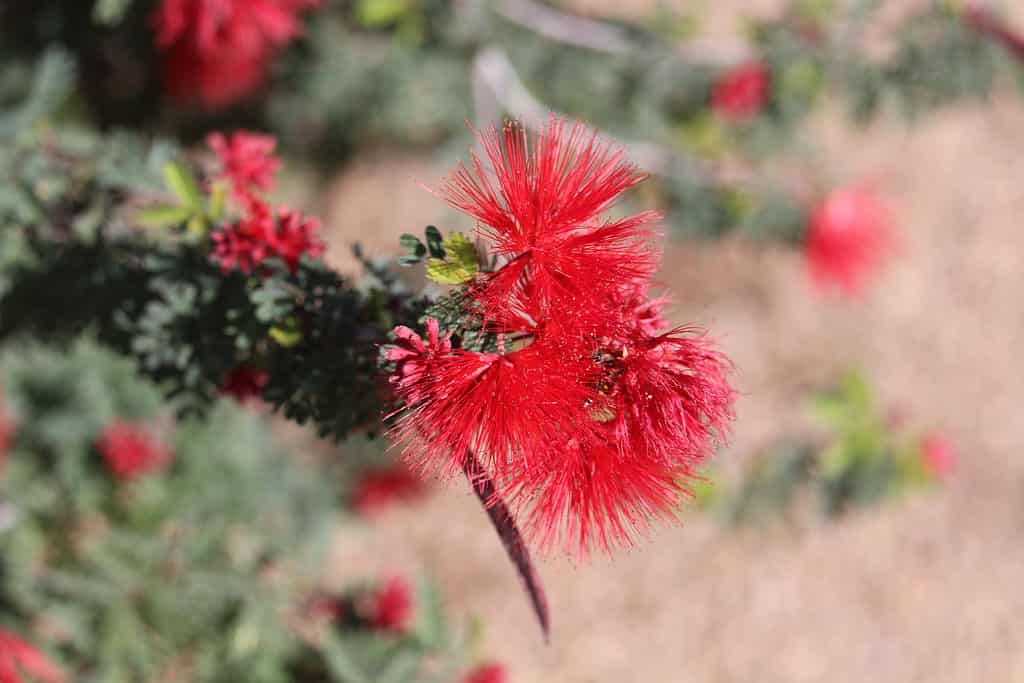
Depending on the variety, fairy duster plants can grow 1 to 5 feet tall and wide.
©Selina S/Shutterstock.com
2. Forget-Me-Nots (Myosotis)
One of the most iconic flowers that start with F is the forget-me-not. These small and delicate wildflowers are most often blue, but they also can have white or pink petals as well. They’re native to North America, Europe, and Asia, and can typically grow in moist, shaded areas. In addition to their aesthetic appearance, forget-me-nots also carry a strong symbolic meaning, representing fidelity and remembrance. Some say that the flower’s name comes from a German legend about a knight who was trying to get the flowers for his lover. Tragically, the knight died, just as he cried out, “Forget me not!”
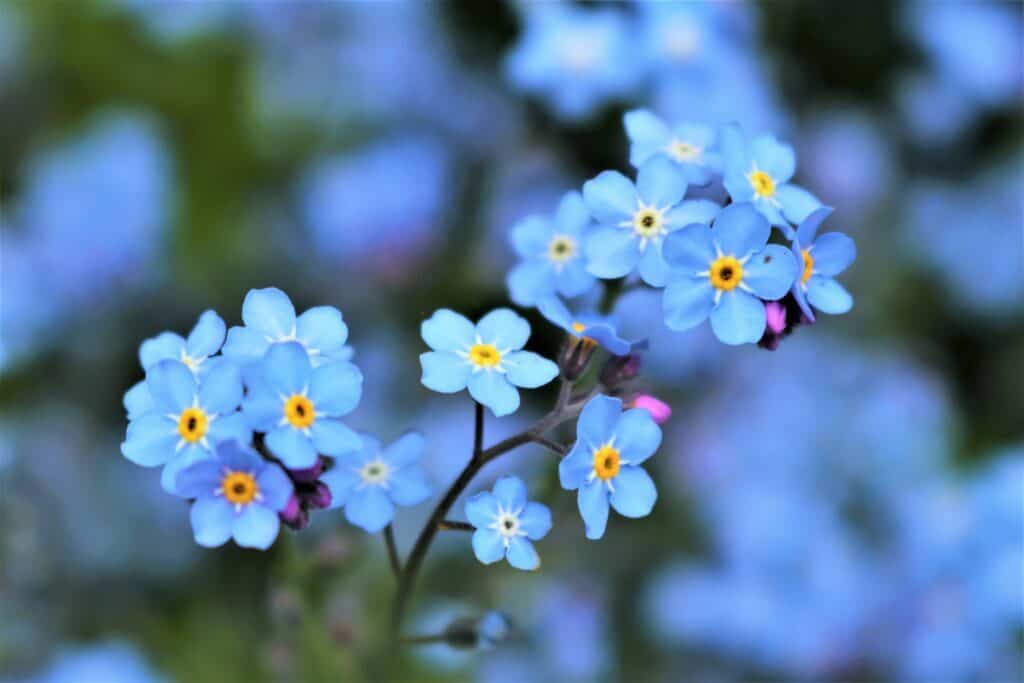
Forget-me-not flower blooms do not last long, but they are a happy addition to any garden bed.
©iStock.com/Agnieszka Klimaszewska
3. Firethorn (Pyracantha)
The tiny white, star-shaped flowers of the firethorn attract buzzing bees and butterflies with their delicate fragrance. These lovely little flowers grow in clusters on the ends of the branches of evergreen firethorn shrubs or small trees. Firethorn plants are well-known for their thorny branches, which provide an extra layer of protection against unwelcome visitors. In addition to the plants’ beautiful flowers, it also produces vibrant yellow, orange, and red berries.
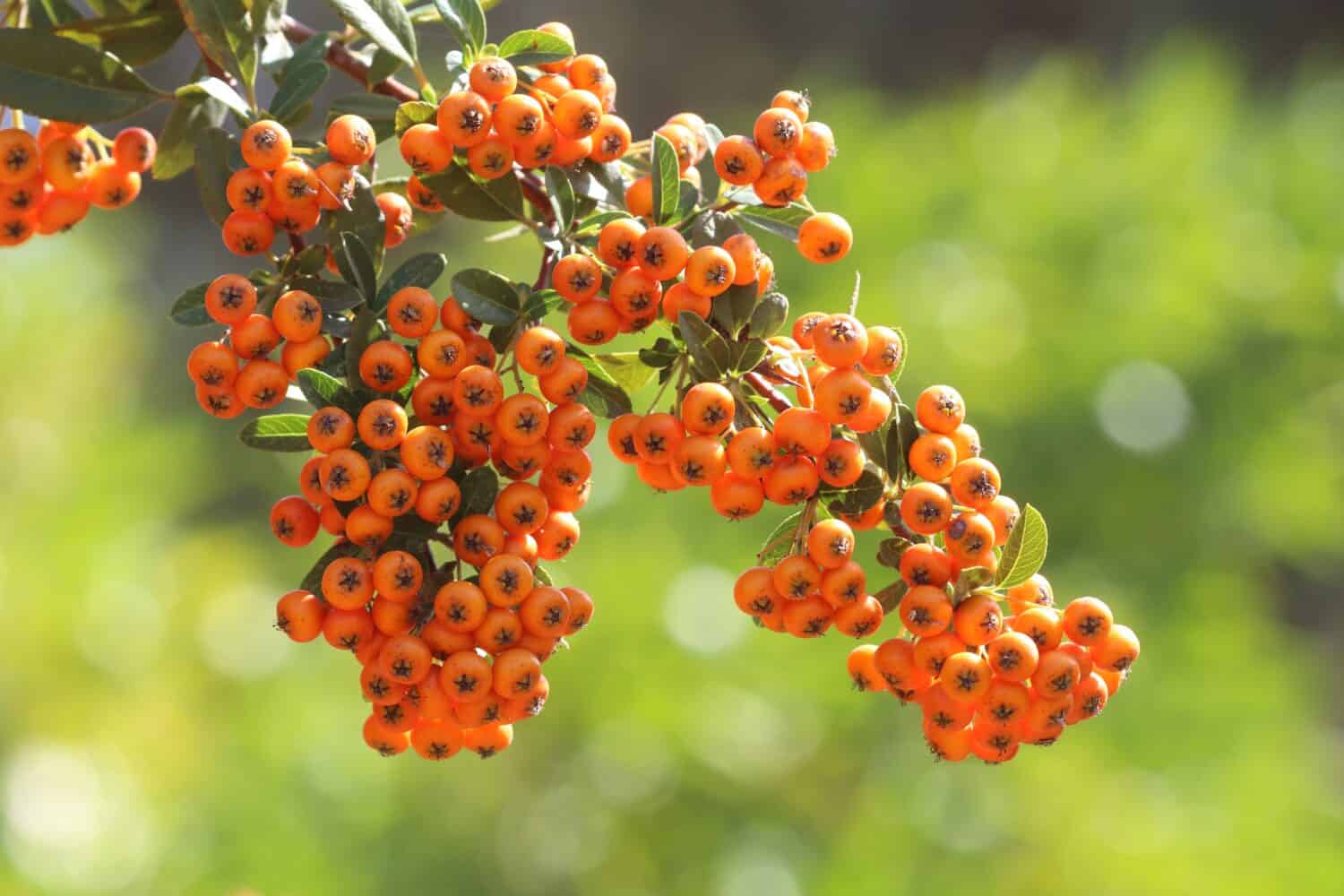
Although the thorny branches may be off-putting, you can use the colorful firethorn berries to whip up a batch of jam or jelly.
©Uunal/Shutterstock.com
4. Flax Flower (Linum usitatissimum)
Available in a range of colors including blue, yellow, white, and red, flax flowers are native to Asia, Europe, and Africa where they grow along roadsides, as well as in fields and meadows. In addition to their delightful appearance, flax flowers are also edible, and many people use them as a garnish or in salads. Flax seeds can be harvested to create flaxseed oil, a healthy oil high in omega-3 fatty acids.
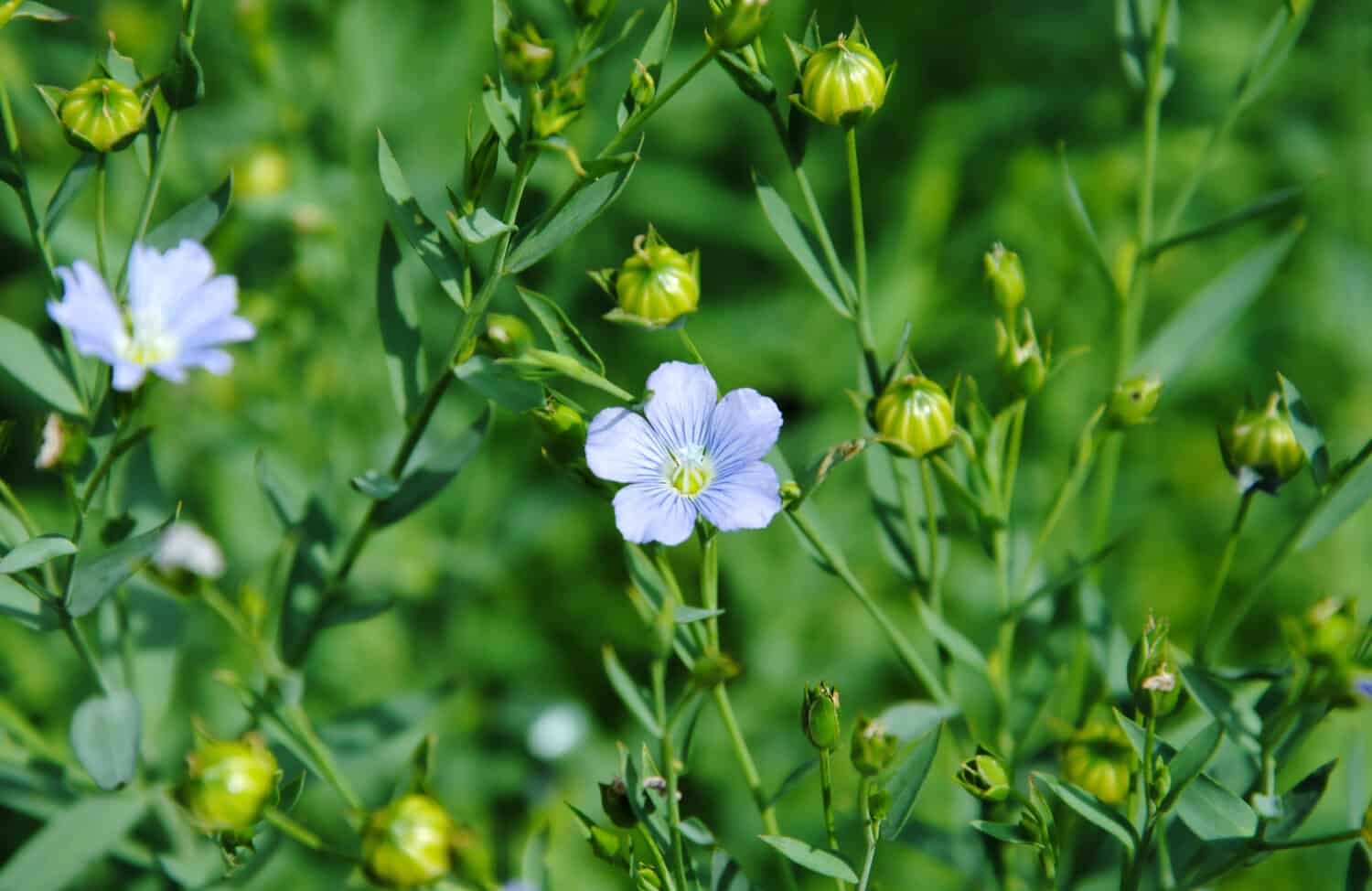
Some people use flax flower plant fibers for making textiles like paper, rope, and cloth.
©marineke thissen/Shutterstock.com
5. Freesia (Freesia refracta)
Freesia are trumpet-shaped flowers that come in a range of different colors, including yellow, pink, red, white, orange, lavender, and purple. These beautiful flowers that start with F are native to South Africa. They are perennials that grow from corms, which are similar to bulbs, and they belong to the iris family. But what sets these lovely flowers apart is their captivating fragrance — a delicate yet refreshing blend of sweetness and citrus.
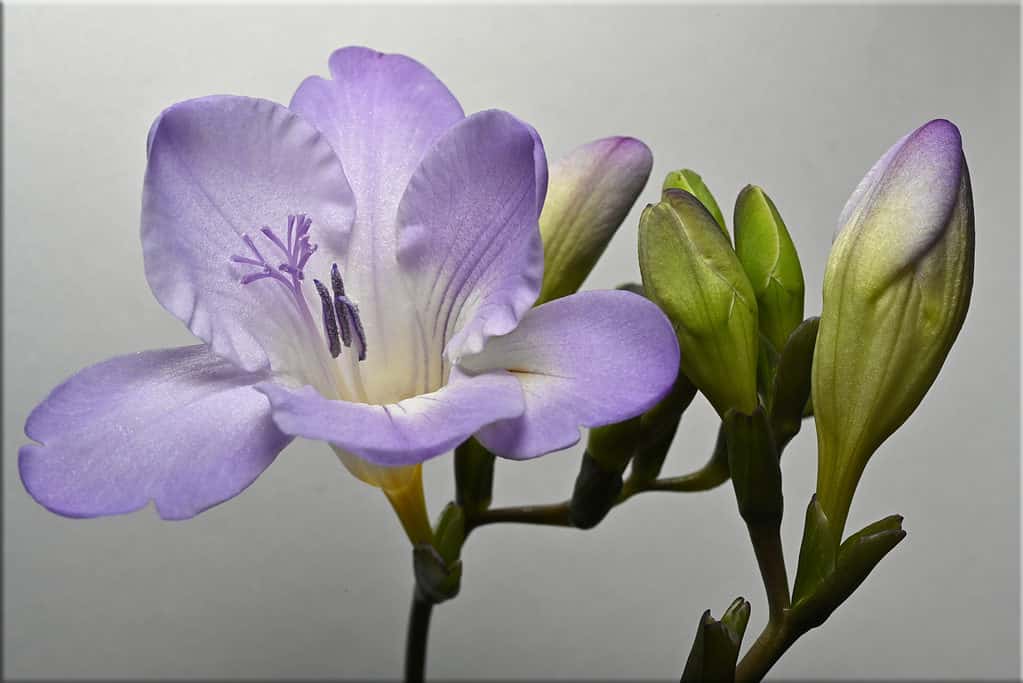
Freesia are edible and loaded with antioxidants.
©iStock.com/Collinswood Images
6. False Indigo (Baptisia)
Standing 3 to 4 feet tall, false Indigo plants are perennials that attract pollinators like butterflies and bees. They are also deer-resistant and poisonous to humans and animals if eaten. False indigo flowers resemble the flowers on pea plants and are typically white or blue, although they can also be pink or yellow. They are native to North America, where historically people used them to create a blue dye — which is why they are called “false indigo”.
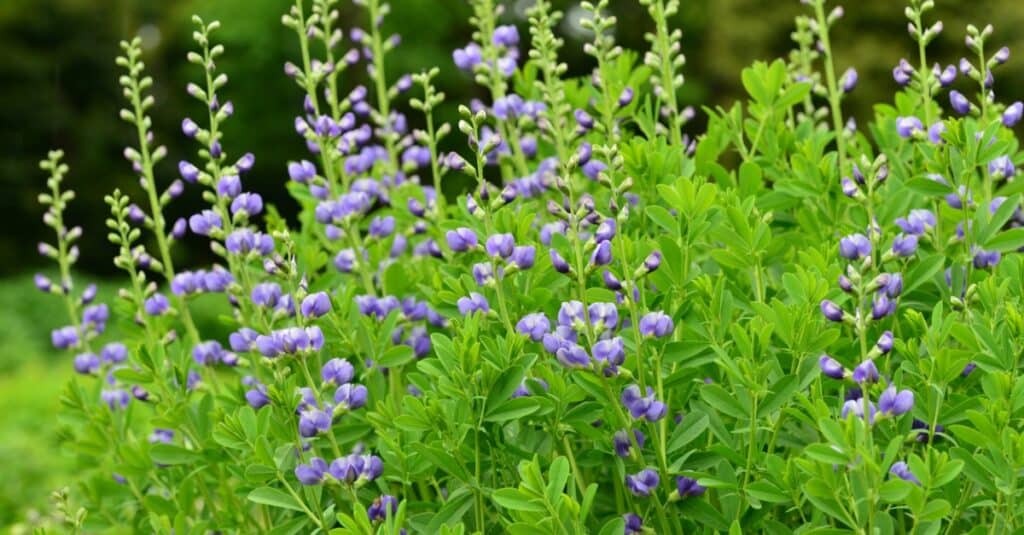
False Indigo plants have been used in traditional medicine to treat ailments like sore throats, coughs, and colds.
©iStock.com/magicflute002
7. Foxglove (Digitalis purpurea)
The scientific name of the foxglove flower comes from the Latin words “digitus”, which means “finger”, and “purpura”, meaning “purple”. Foxglove plants have tall, slender spikes of bell-shaped flowers that are purple, pink, yellow, or white. They can grow up to 3 to 6 feet tall and attract bees and butterflies. It’s interesting to note that they carry the risk of toxicity to humans and animals if ingested, but they have also been used medicinally for centuries to treat heart conditions.
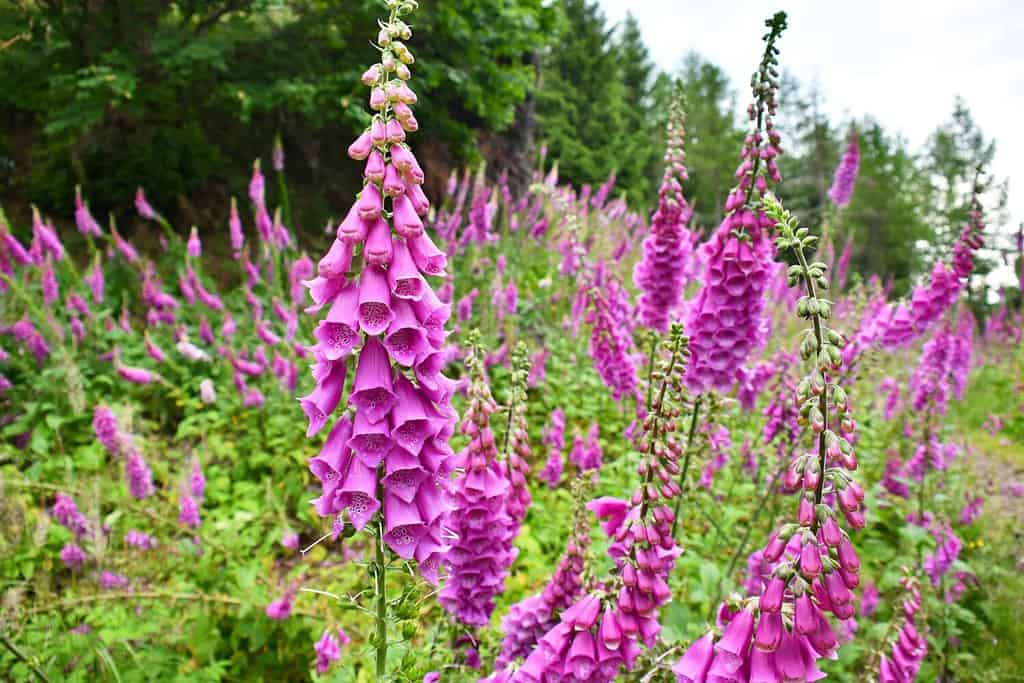
Foxglove is very toxic for humans to eat, and can even be fatal if ingested.
©HAL-9000/Shutterstock.com
8. Flannel Flower (Actinotus helianthi)
Australia is home to the delightful flannel flower, a delicate yet robust plant with velvety gray-green foliage and daisy-like flowers that bloom in a range of colors from white to sunny yellow or orange. Flannel flowers can grow up to 1 to 2 feet tall and spread out to form colonies. The flower’s scientific name, Actinotus helianthi, comes from the Greek words “aktinos” meaning “ray” and “helios” meaning “sun.” These flowers look like little miniature suns due to their shape and cheerful presence.
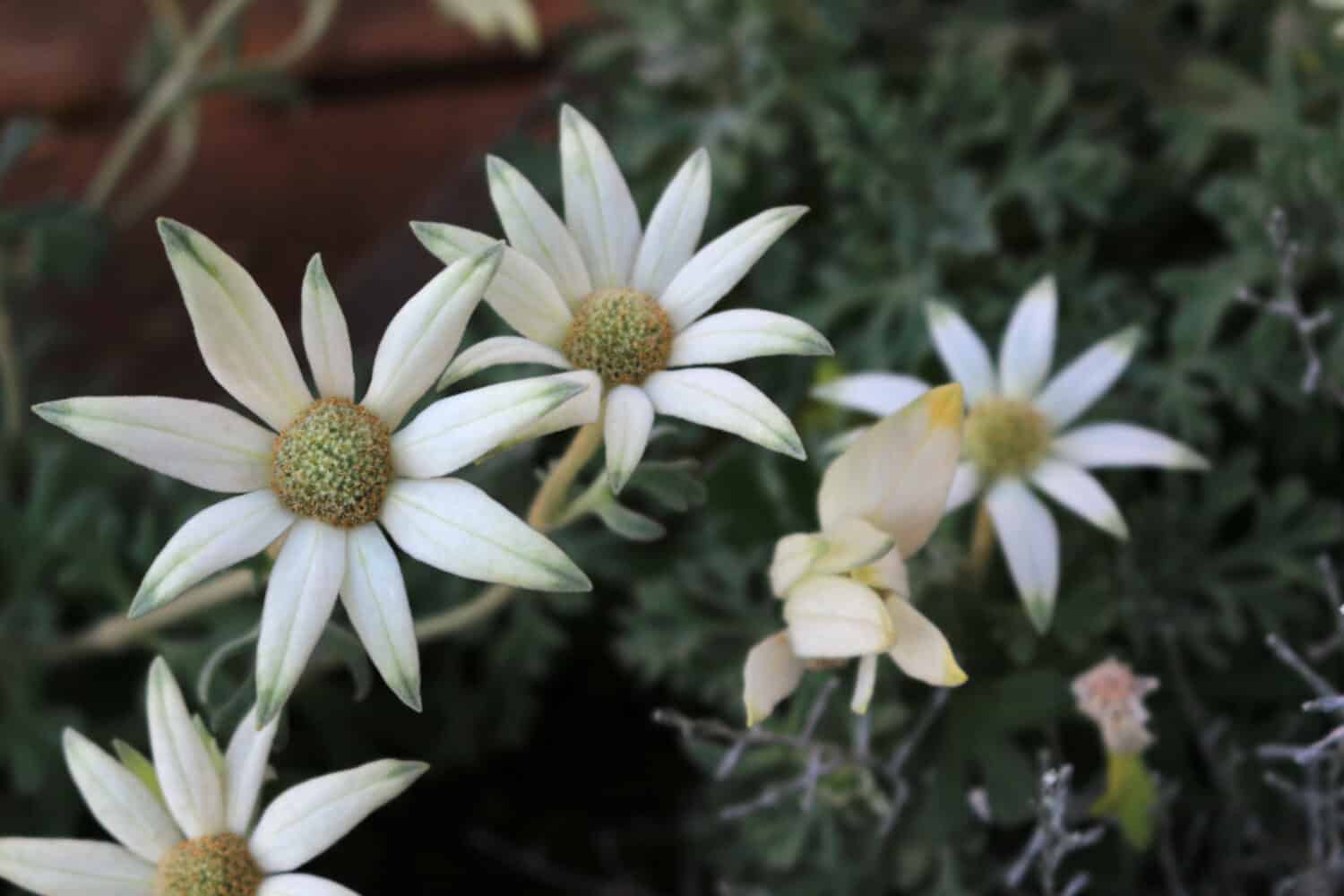
Flannel flower plants have a soft and woolly texture, like flannel fabric.
©kazuhiro/Shutterstock.com
9. Forsythia (Forsythia x intermedia)
Blooming in early spring with a sunny burst of yellow flowers, Forsythia symbolizes new beginnings. Native to East Asia, these bright and cheery flowers grow on towering shrubs that are 6 to 8 feet tall and wide. Although they are not edible, Forsythia flowers are inviting to pollinators like bees and butterflies. However, it is important to note that Forsythia is poisonous to dogs and cats if they eat it. The flower’s name comes from William Forsyth, a Scottish botanist and one of the founders of the Royal Horticultural Society in the early 1800s.
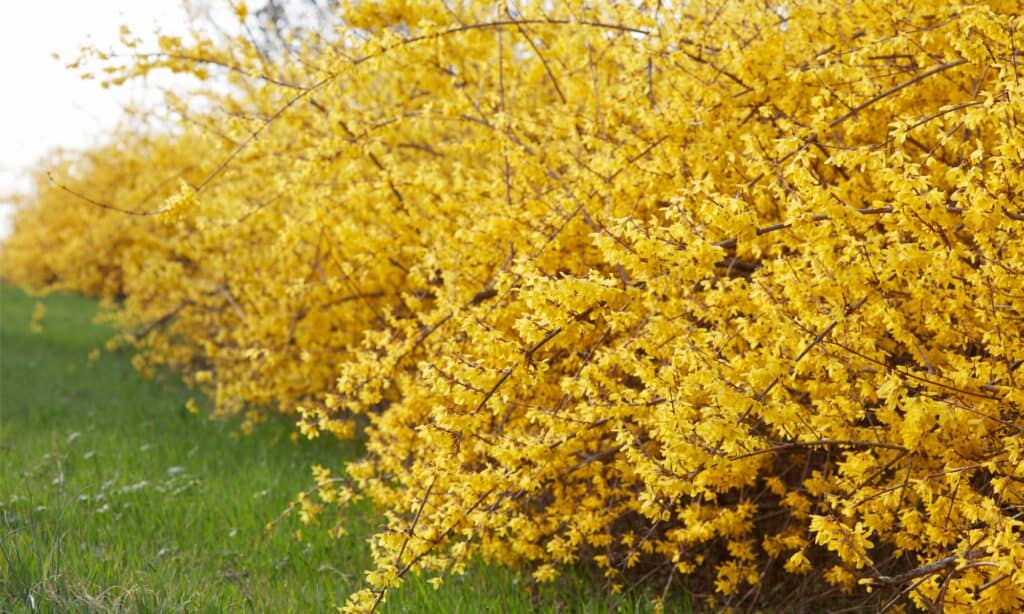
The Forsythia flower’s name comes from William Forsyth, a Scottish botanist and one of the founders of the Royal Horticultural Society in the early 1800s.
©iStock.com/AndreaAstes
10. Fuchsia (Fuchsia)
With a kaleidoscope of vibrant colors, Fuschia flowers are a dazzling addition to any garden. These dainty, bell-shaped blooms grow on many different plant forms, from vines to shrubs and trees — some of which can grow up to 3 to 6 feet tall. Hailing from Central and South America, these stunning flowers have a unique charm and are especially alluring to hummingbirds. Fuchsia flowers also make great gifts, as they symbolize love and romance. However, be sure to keep them out of reach of any cats and dogs as they are toxic if ingested.
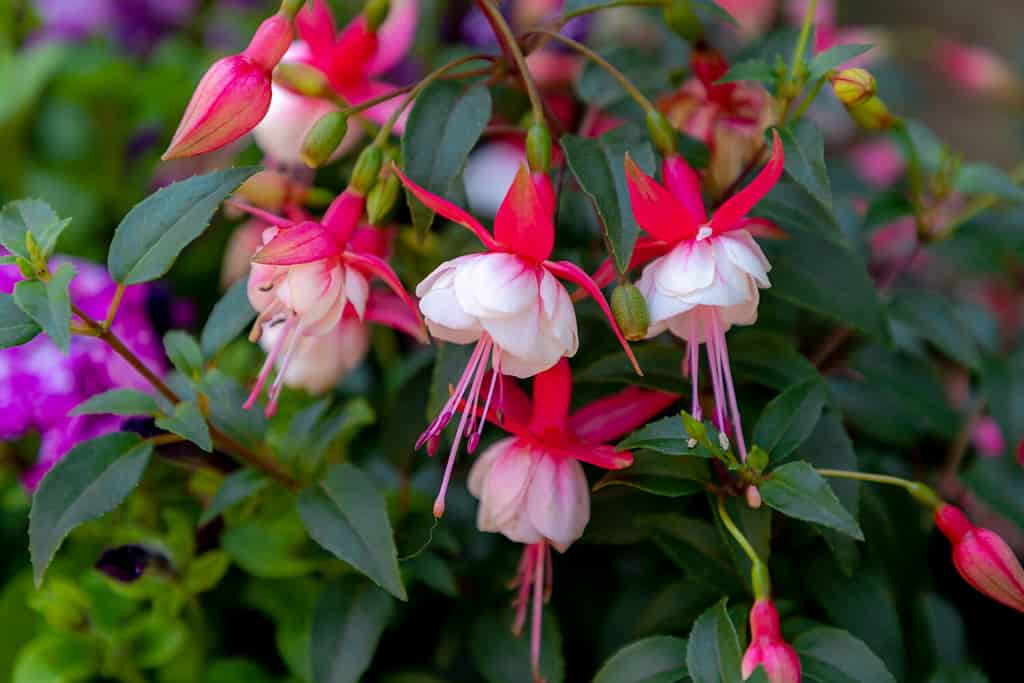
In warmer climates, fuchsia flowers can come back every year.
©Wut_Moppie/Shutterstock.com
11. Firetail Fleece (Persicaria amplexicaulis ‘Firetail’)
As the summer sun beats down from midsummer to fall, firetail fleece flowers burst in a fiery display of crimson red blooms. Native to Asia, these perennials have stunning, 6-inch long bottle brush-shaped spikes. The flower’s name comes from its fiery colors, which look like flowery flames dancing atop it. And, not unlike fire, firetail fleece flowers aren’t particularly cold-hardy and need to be protected from frost.

Firetail fleece flowers grow very well in moist areas.
©Peter Turner Photography/Shutterstock.com
12. Fairy’s Thimbles (Campanula cochleariifolia)
Nestled within rocky outcroppings, woodlands, and meadows, fairy’s thimbles flowers enchant anyone who happens upon them! These delicate perennial plants come from Europe and Asia and have blue, pink, and white flowers. Their name comes from the plant’s petite, bell-shaped blooms that look like little sewing tools woodland fairies might use. Fairy’s thimbles also have cute, ear-shaped leaves.
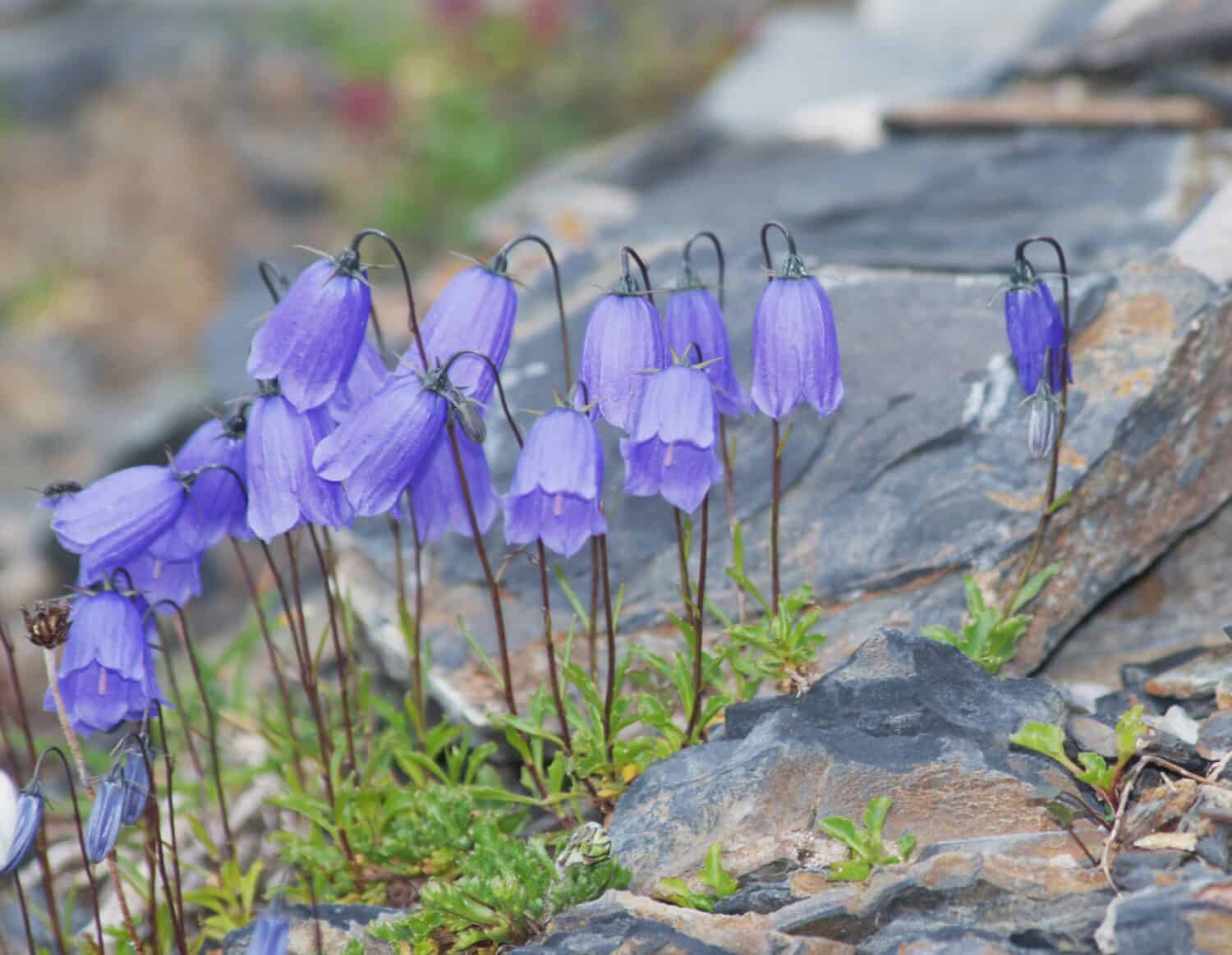
Fairy’s thimbles are small plants, but they spread out to form a mat-like colony, attracting butterflies and bees to their beautiful blossoms.
©Gherzak/Shutterstock.com
13. Floss Flower (Ageratum houstonianum)
Like whimsical little puff balls or soft tufts of cotton candy, floss flowers are another beautiful flower that starts with F. These fanciful annual flowers come from the sunny regions of Mexico and Central America. Floss flowers have clusters of small blue, purple, or white flowers with tiny thread-like petals that give them a fluffy appearance. A member of the daisy family, floss flowers grow 6 to 12 inches tall.
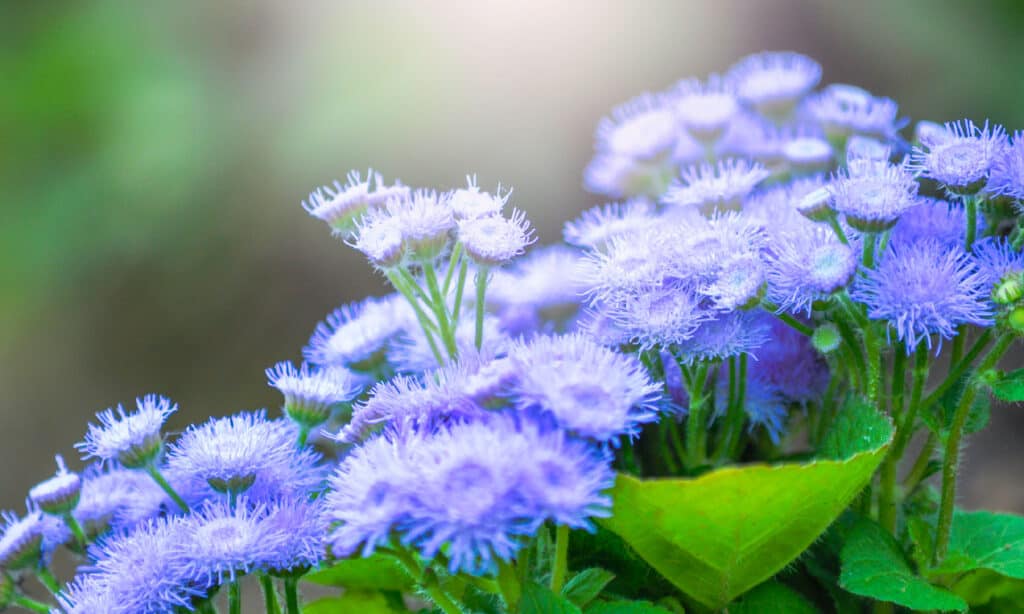
Floss flowers are perfect for butterfly gardens and attract a variety of pollinators.
©undefined undefined/Shutterstock.com
14. Flaming Katy (Kalanchoe blossfeldiana)
Native to Madagascar, Flaming Katy flowers bloom from a unique type of succulent that grows up to 18 inches tall and forms a lovely mounded shape. Flaming Katy plants have eye-catching clusters of small tubular flowers surrounded by breathtakingly colorful bracks. These stunning flowers are aflame with color, with hues ranging from fiery reds to sunny yellows and blazing oranges. Their beautiful blossoms burst open in the winter and spring, adding a vibrant touch of color to these cooler seasons.
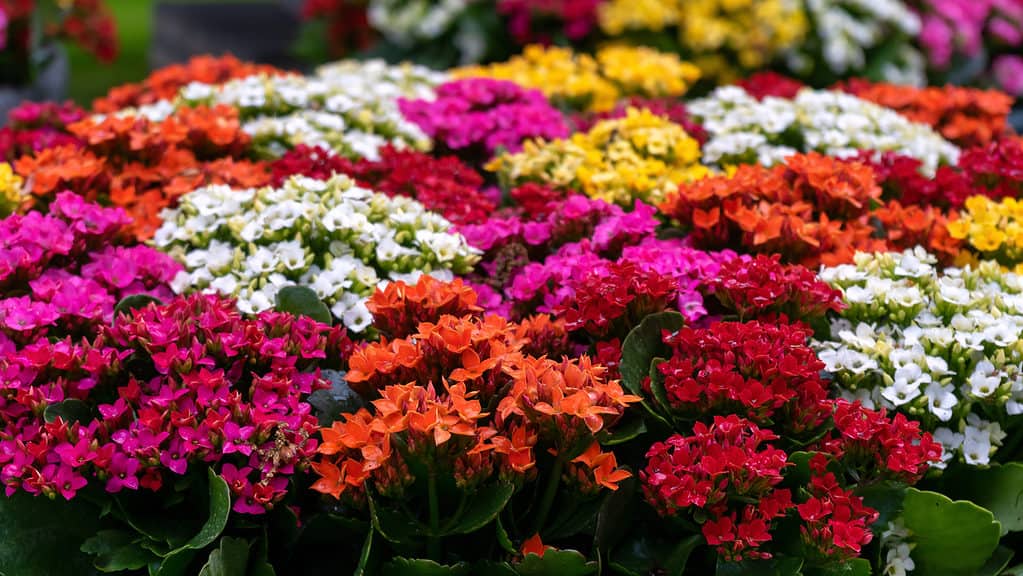
The most common kalanchoe has vibrant, showy blooms that vary in color.
©iStock.com/Maksims Grigorjevs
15. False Goat’s Beard (Aruncus dioicus)
This captivating perennial goes by many different names, including false goat’s beard, great masterwort, and plume poppy. False goat’s beard is famous for its tall, fern-like plumes of colorful flowers. The blooms are made up of tons of tiny, individual florets that are organized in conical, spike-like clusters. They are soft and airy, and look like the beard of a goat!
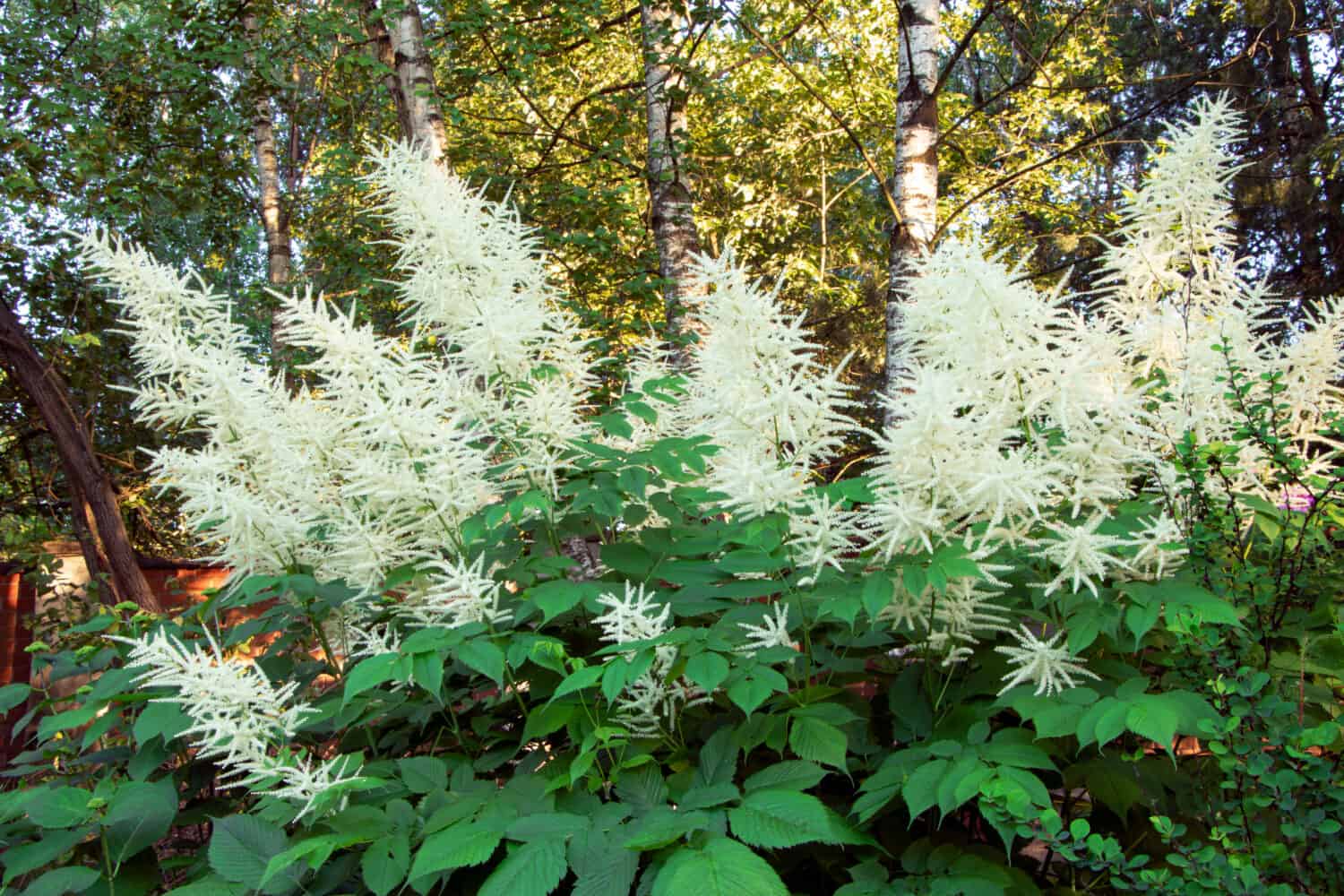
False goat’s beard are great for attracting butterflies and birds.
©Dyfrain/Shutterstock.com
16. Fan Columbine (Aquilegia flabellata)
These beautiful flowers that start with F are herbaceous perennials that originally come from Russia, China, and Japan. They have unique, fan-shaped flowers that seem to nod like tiny little bonnet-covered heads. Each exquisite bloom is made up of five delicate petals in mesmerizing shades of purple, blue, and white. Fan columbine plants grow up to 1 to 2 feet tall and spread out to form a clump, providing a stunning display of color and texture in any garden. They also have sweet nectar and attract pollinators like hummingbirds and butterflies.

Fan columbine flowers bloom in early summer.
©Dajra/Shutterstock.com
17. Firecracker Flower (Crossandra infundibuliformis)
Firecracker flowers bloom on evergreen shrubs in India and Sri Lanka. They are famous for their bold and brightly colored tubular flowers that come in fiery shades of yellow, red, and orange. The stunning blossoms bloom in clusters throughout the spring and fall, and each one has five petals and a spur at the end filled with nectar. So, not only do these spectacular flowers add a pop of color to your garden, but they also provide a tasty treat for butterflies and hummingbirds as well.
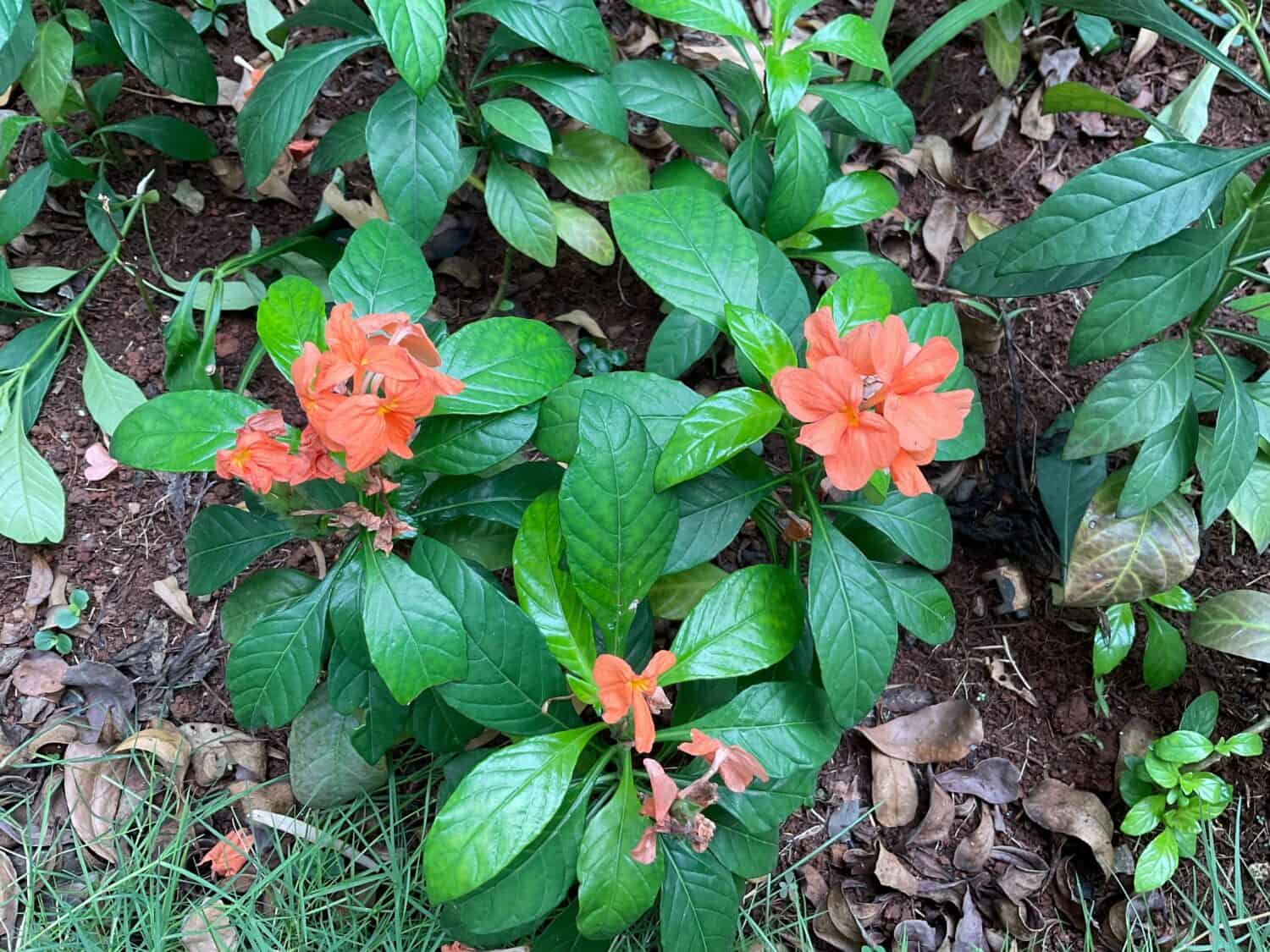
Firecracker flower
plants can grow up to 2 to 3 feet tall and wide, making them perfect additions to any outdoor space that needs a touch of pizzazz.
©Rati Siregar/Shutterstock.com
18. Frangipani Flower (Plumeria)
This tropical plant is native to the lush landscapes of Central and South America and is famous for its fragrant, trumpet-shaped flowers. Frangipani flowers come in all sorts of dazzling colors, from paradisiacal whites to sunny yellows, passionate pinks, fiery oranges, and rich reds. The plants grow to a towering height of 10 to 20 feet. In fact, although they are not native to the islands, Frangipani flowers (or plumeria) are one of the most common blossoms in Hawaiian leis.

The name Frangipani comes from an Italian nobleman in the sixteenth century who created a perfume that smelled like these flowers.
©AJWalsh/Shutterstock.com
19. Fivespot Flower (Nemophila maculata)
Fivespot flowers are annual wildflowers native to the sunny state of California. They go by many different names, including fivespot, five-spot baby, baby blue eyes, and starflower. These charming flowers have mall and delicate white petals that each have a striking dark purple spot on the tip. Blooming in the spring and summer, fivespot flowers grow along roadsides, as well as in meadows and disturbed areas.
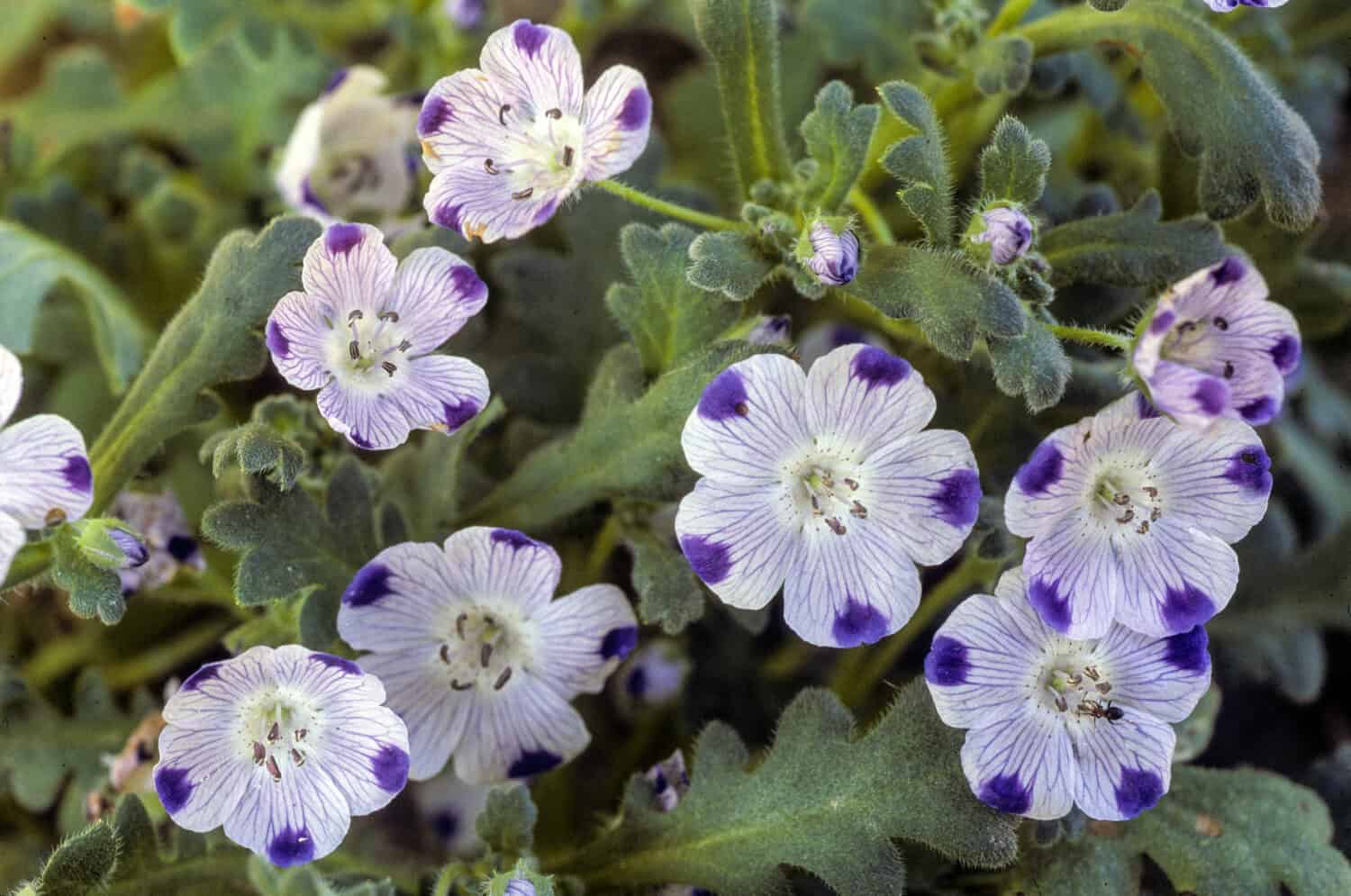
Fivespot flowers attract pollinators like butterflies, bees, and hummingbirds.
©COULANGES/Shutterstock.com
20. Four O’Clock Flower (Mirabilis jalapa)
With their beautiful and exotic appearance, four o’clock flowers are known for their fragrant, trumpet-shaped blooms. These blossoms open in the late afternoon or evening, filling the air with an alluring, tropical scent. They are perennial flowers that originate in South America and come in a wide variety of colors like yellow, pink, orange, red, white, and purple. There are also bicolored or tricolored varieties, adding the perfect touch of whimsical charm to any garden.
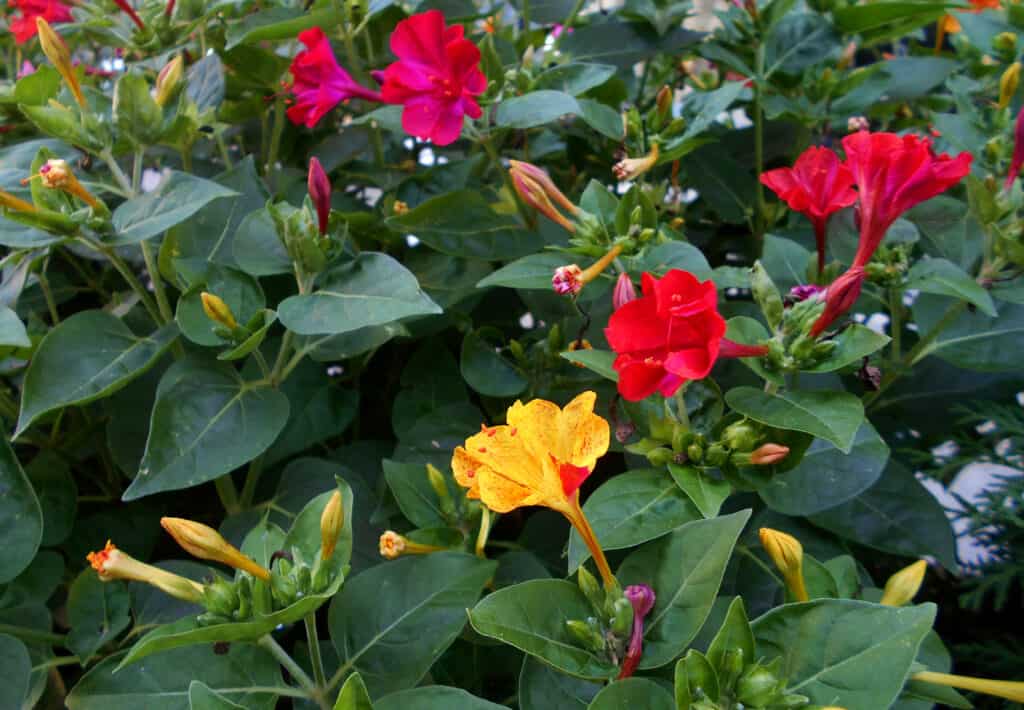
In addition to their beauty, four o’clock plants have many uses — in food coloring, as an edible dye, and in herbal medicine.
©iStock.com/Magdevski
21. False Ruse Anemone (Enemion biternatum)
At a height of only 4 to 8 inches tall, the false ruse anemone may seem small, but this graceful wildflower is bursting with beauty and allure. False ruse anemone flowers are just 0.5 inches long and bloom in cup-like shapes with five white sepals that look like petals. Their trifoliate leaves are just as beautiful as their blossoms, with each leaf divided into three smaller oval or heart-shaped leaflets.
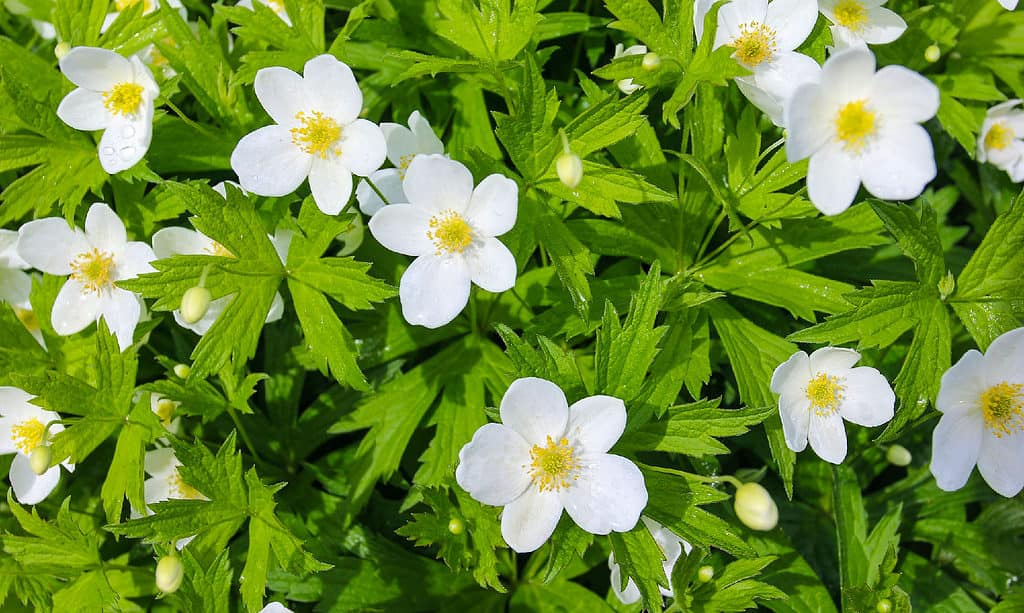
The false rue anemone is a deciduous woodland plant in the eastern regions of the U.S. and in the extreme southern part of Ontario.
©iStock.com/walencienne
22. Farewell-to-Spring (Clarkia amoena)
Blooming in the spring and summer months, the farewell-to-spring flower is an annual wildflower that grows up to 2 feet tall. It has slender stems with cup-shaped blooms. Each flower has four delicate petals that range from pink to red, white, and lavender. Its petals have a darker blotch at their base, adding dimension to the flower’s incredible beauty. Farewell-to-spring flowers close up at night and reopen in the morning, creating a unique and captivating garden experience.
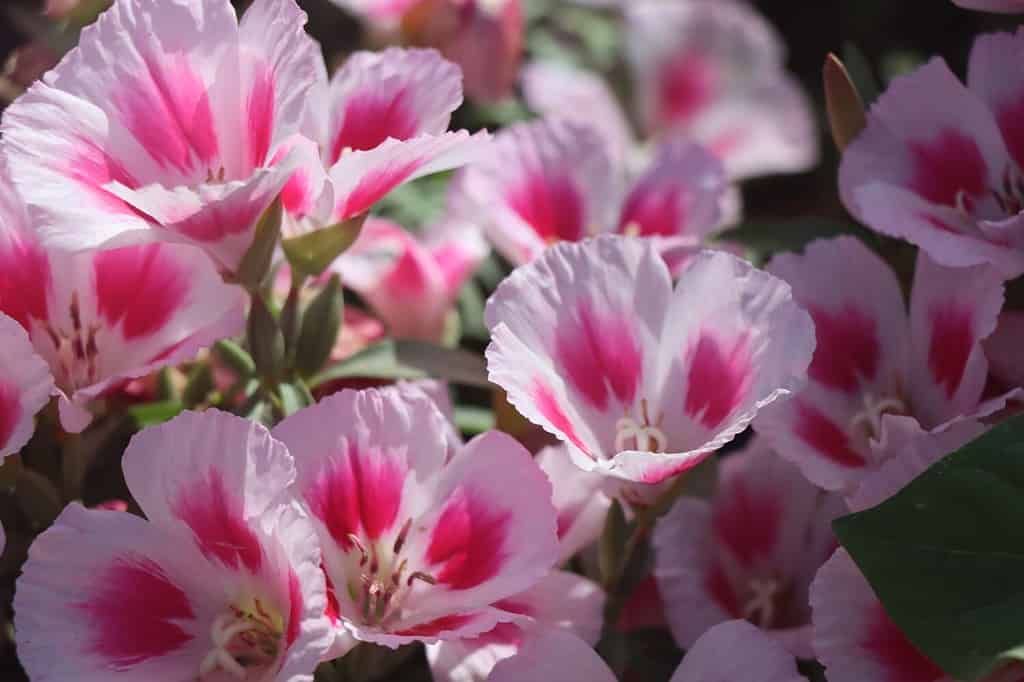
Farewell-to-spring flowers are beautiful annual wildflowers native to the western regions of North America.
©Avakov/Shutterstock.com
23. False Bird of Paradise (Heliconia)
The stunning bracts, or leaf-like structures surrounding the flowers of the false bird of paradise come in many brilliant colors, ranging from yellow to red and pink. The petite flowers themselves are quite small, but they are also brightly colored with orange or yellow, complementing the eye-catching bracts. These exotic and vibrant flowers come from Central and South America, and some species can grow up to 10 feet tall!

False bird of paradise flowers are also called lobster-claws, wild plantains, and toucan beaks.
©Michaelnero/Shutterstock.com
24. Flamingo Flower (Anthurium andraeanum)
A member of the same family as peace lilies and philodendrons, the dazzling flamingo flower has a unique shape that is sure to catch your eye. Its slender spadix (the central spike of the flower) is surrounded by a heart-shaped and brightly colored leaf called a spathe. The shade of the spathe varies between species, ranging from deep reds to shocking pinks and striking whites.
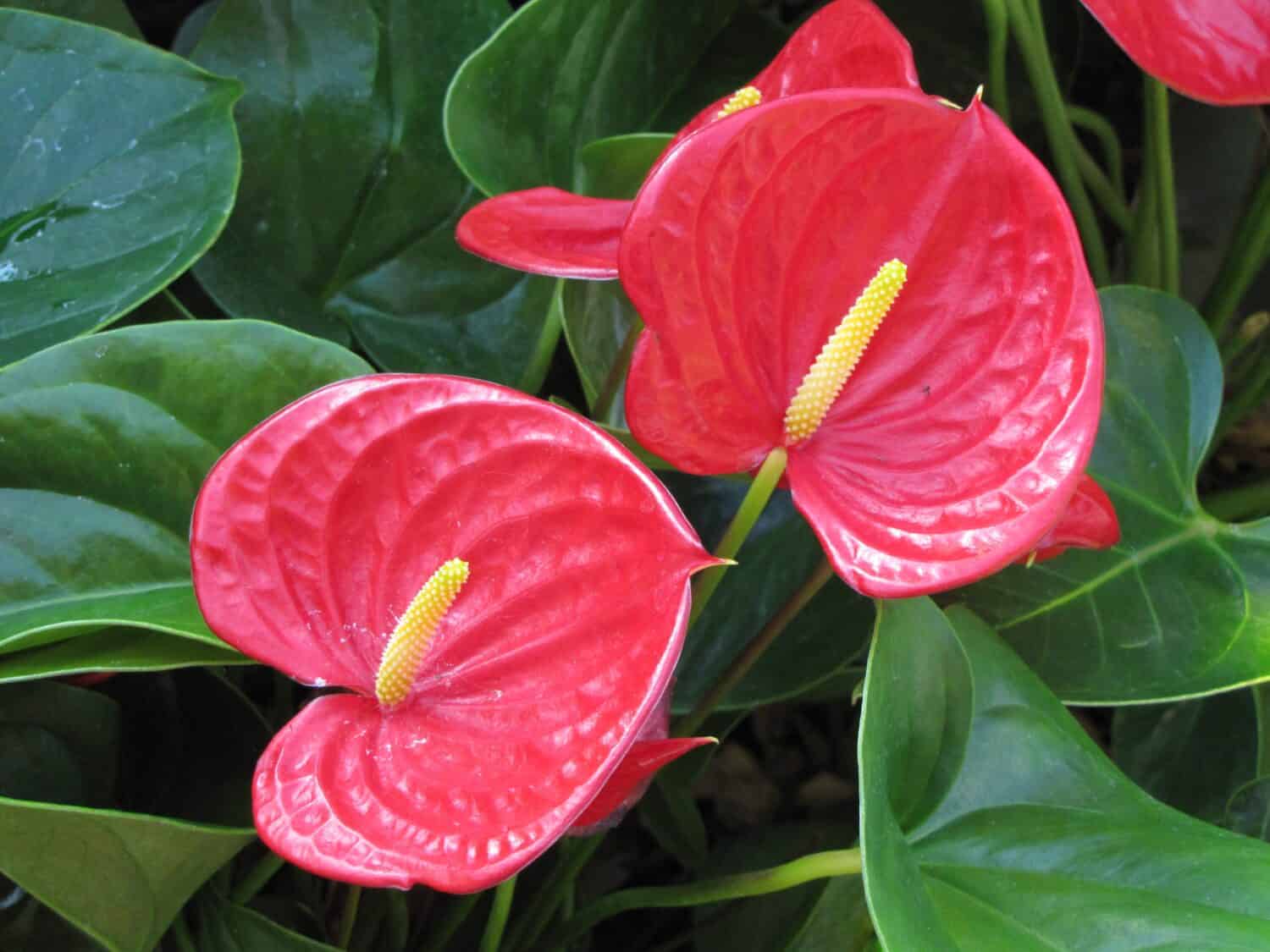
Flamingo flowers come from Central and South America and grow up to 3 feet tall.
©Shurik the Creator/Shutterstock.com
25. Fuji Mum (Chrysanthemum)
The thin and elongated petals of the Fuji mum make it stand out from other chrysanthemum varieties. These beautiful flowers that start with F come in many different colors such as lavender, pink, orange, yellow, and white. Fuji mums can grow up to 2 feet tall, with blossoms that are 2 to 3 inches in diameter. Native to China and Japan, Fuji mums bloom in the fall, and their flowers can last for several weeks.
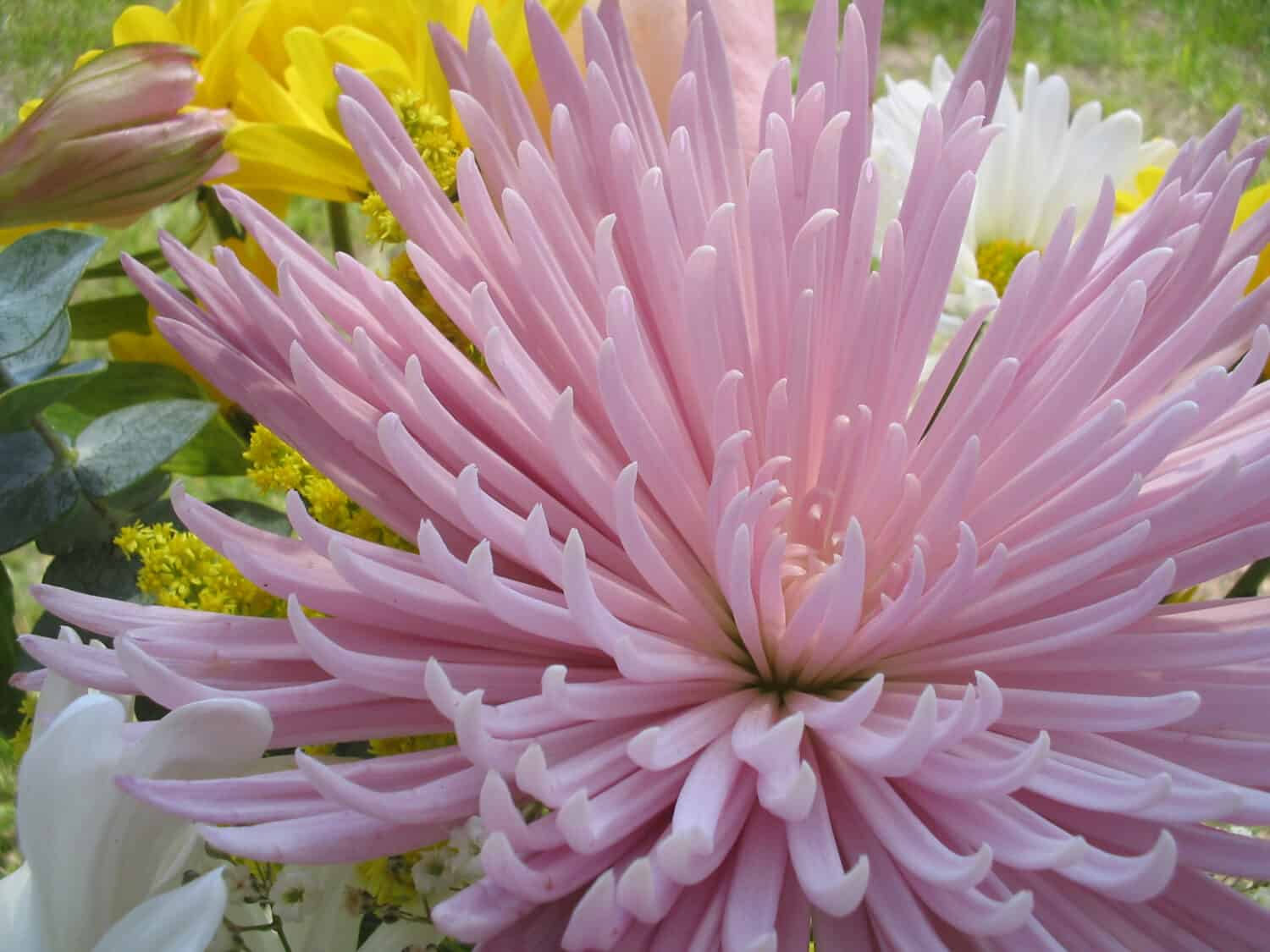
Sometimes fuji mums are also called spider mums because their unique spindly petals look like spider legs!
©Lindsay Franklin/Shutterstock.com
26. Fernleaf Yarrow (Achillea filipendulina)
Native to Asia and Europe, the charming fernleaf yarrow is a perennial flower from the daisy family. Its bright yellow flowers add a cheerful touch of sunshine to any landscape and come back year after year. Fearleaf yarrow plants can grow 2 to 4 feet tall with green, slightly hairy leaves. Their flowers are clustered together at the top, blooming for several weeks during the summer. Fernleaf yarrow is a special plant that is drought-tolerant, deer-resistant, and edible.

Fernleaf yarrow has been used to treat a number of medical conditions, from wounds and fevers to pain and inflammation.
©AngieC333/Shutterstock.com
27. French Marigold (Tagetes patula)
These annual flowers are native to Guatemala and Mexico. French marigolds are delightful flowers that add a pop of color to any garden with their red, brown, orange, and yellow variegated colors. With their almost daisy-like appearance, each flower has a single row of soft and velvety petals circling a central disc in a burst of color. These cheerful flowers bloom from the early summer months into the fall and grow 6 to 12 inches tall.
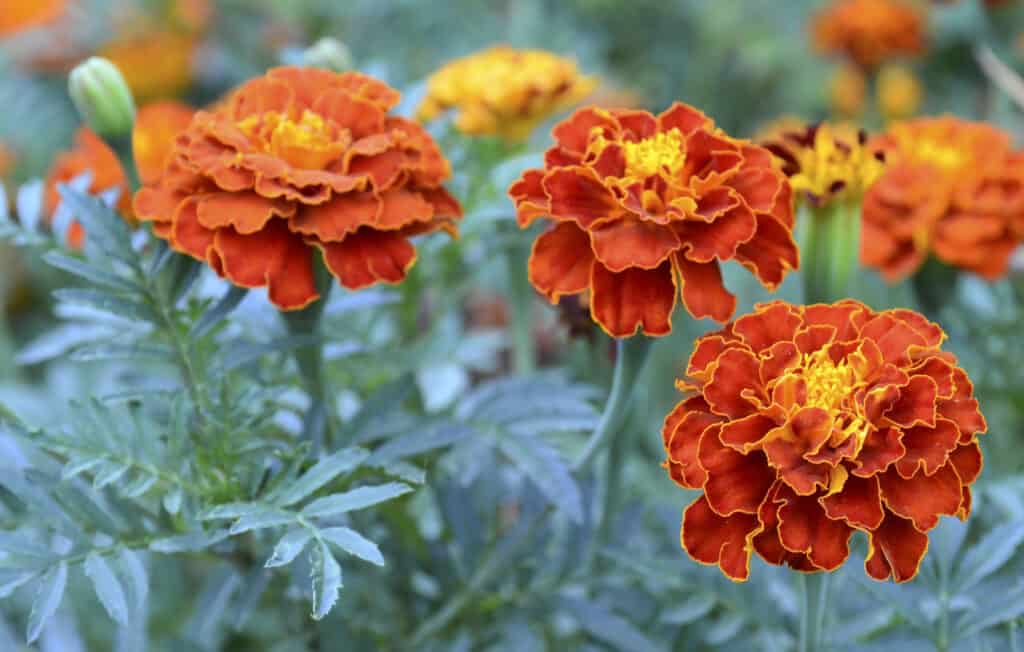
French marigold flowers have edible blossoms, and the leaves are sometimes used in a special tea to help with fever and stomach problems.
©iStock.com/svf74
28. Feverfew (Parthenium)
Another member of the daisy family, feverfew flowers feature luscious fern-like leaves with a slightly furry texture. During the summer, these plants put on a show-stopping display of dainty daisy-like flowers with tiny white petals and a sunshiny yellow center. For hundreds of years, feverfew has been respected for its therapeutic benefits, treating a range of conditions from fevers to headaches. These beautiful flowers that start with F contain a unique compound called parthenolide, which is thought to inhibit the release of certain chemicals in the brain that trigger pain and inflammation.
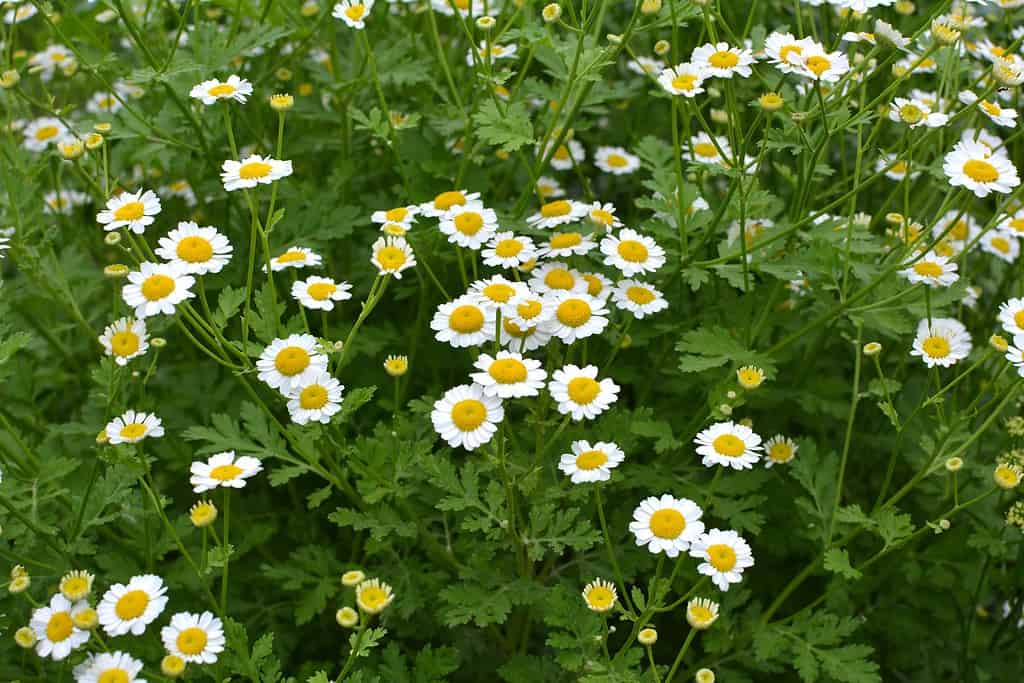
Feverfew flowers are sometimes called bachelor’s buttons or featherfew.
©Orest lyzhechka/Shutterstock.com
Summary of Beautiful Flowers That Start With F
| Common Name | Scientific Name |
|---|---|
| Fairy Duster | Calliandra eriophylla |
| Forget-Me-Not | Myosotis |
| Firethorn | Pyracantha |
| Flax Flower | Linum usitatissimum |
| Freesia | Freesia refracta |
| False Indigo | Baptisia |
| Foxglove | Digitalis purpurea |
| Flannel Flower | Actinotus helianthi |
| Forsythia | Forsythia x intermedia |
| Fuschia | Fuschia |
| Firetail Fleece | Persicaria amplexicaulis ‘Firetail’ |
| Fairy’s Thimbles | Campanula cochleariifolia |
| Floss Flower | Ageratum houstonianum |
| Flaming Katy | Kalanchoe blossfeldiana |
| False Goat’s Beard | Aruncus dioicus |
| Fan Columbine | Aquilegia flabellata |
| Firecracker Flower | Crossandra infundibuliformis |
| Frangipani Flower | Plumeria |
| Fivespot Flower | Nemophila maculata |
| Four O’Clock Flower | Mirabilis jalapa |
| False Ruse Anemone | Enemion biternatum |
| Farewell-to-Spring | Clarkia amoena |
| False Bird of Paradise | Heliconia |
| Flamingo Flower | Anthurium andraeanum |
| Fuji Mum | Chrysanthemum |
| Fernleaf Yarrow | Achillea filipendulina |
| French Marigold | Tagetes patula |
| Feverfew | Parthenium |
The photo featured at the top of this post is © Wut_Moppie/Shutterstock.com
Thank you for reading! Have some feedback for us? Contact the AZ Animals editorial team.







